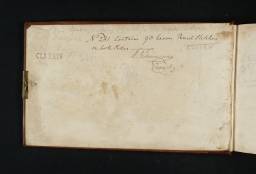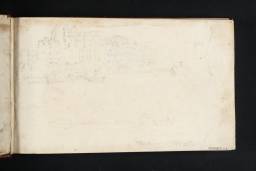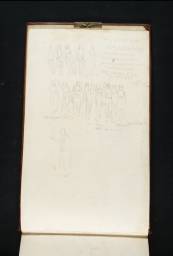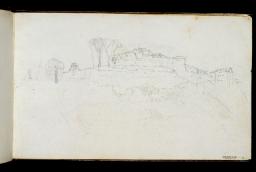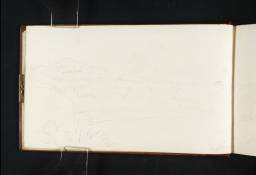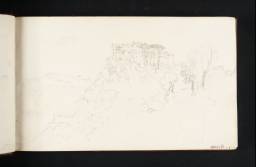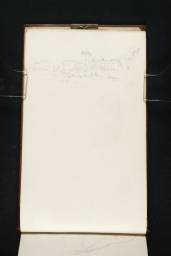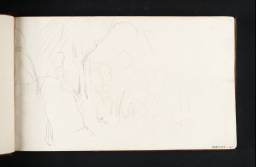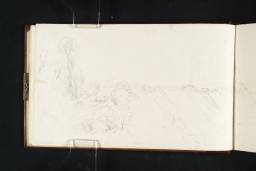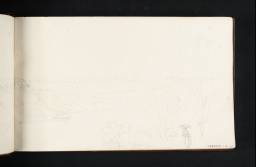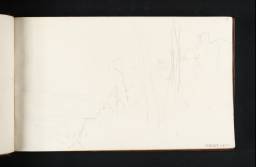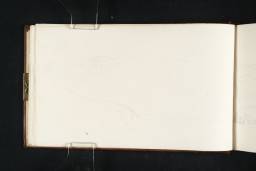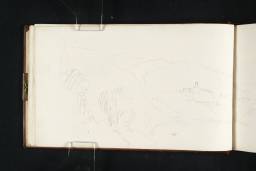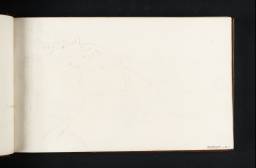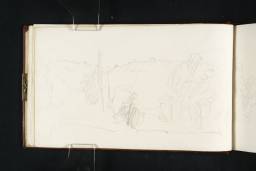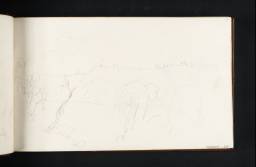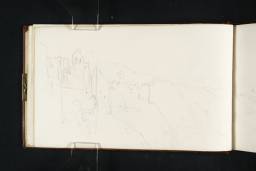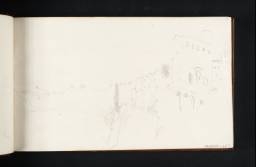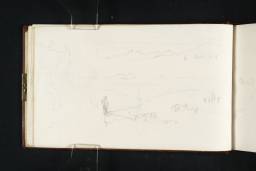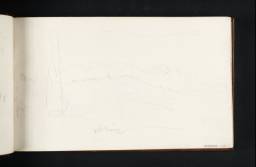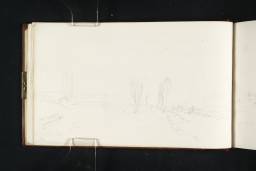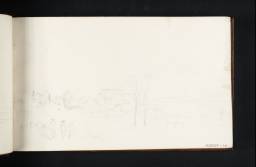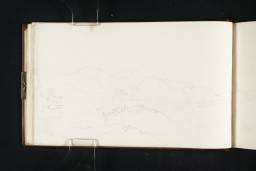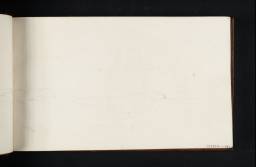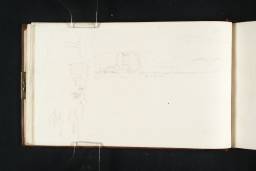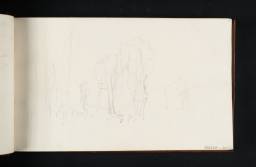Turner Bequest CLXXXIV
Brown leather-bound sketchbook with one brass clasp [missing]. Outer front cover stamped in black ‘CLXXXIV’ top right. Outer back cover inscribed by the artist in black ink ‘Castello Gondolfo to Napoli Bæia | Pozzoli Naples’ top centre (see D40947).
92 leaves of white wove writing paper, approximate page size 122 x 197 mm
Made by William Turner and Son, Chafford Mill, Penshurst, Kent; various pages watermarked ‘W TURNER & SON’
92 leaves of white wove writing paper, approximate page size 122 x 197 mm
Made by William Turner and Son, Chafford Mill, Penshurst, Kent; various pages watermarked ‘W TURNER & SON’
Accepted by the nation as part of the Turner Bequest 1856
Exhibition history
References
Turner used this sketchbook during his first tour of Italy in 1819, one of twenty-three related to that trip. In particular it is one of six sketchbooks which record his expedition to the south of the country.1 As his label on the back cover indicates, the contents comprise studies between Rome and Naples, as well as views of the city and the surrounding area, including Pozzuoli and the Bay of Baiae.
The majority of views in the first part of the sketchbook record the journey south of Rome during early October 1819, particularly from the road between Castel Gandolfo and Capua, see folios 2–35 verso (D15557–D15624; Turner Bequest CLXXXIV 2–34a). The exact dates of the trip are unknown but it is likely to have taken around four days and taken place between 10 and 16 October.2 It has been previously suggested that a drawing of Terracina within this sketchbook bears the inscribed date ‘12 Oct’,3 although this is a misreading of the artist’s handwriting, see folio 23 verso (D15600; Turner Bequest CLXXXIV 22a). There is other existing documentary evidence however to confirm an early October departure. In a letter dated 6 October, Thomas Lawrence wrote to Joseph Farington, ‘Turner is come and going immediately to Naples’,4 although another letter from Lawrence to Antonio Canova indicates that Turner was sketching in the Vatican on the 8th or 9th of the month (see the introduction to the Vatican Fragments sketchbook, Tate; Turner Bequest CLXXX).5 An address written in the inside back cover of the Vatican Fragments sketchbook (see D15250; Turner Bequest CLXXX 81a) has led James Hamilton to conclude that Turner travelled to Naples in company with Thomas Donaldson and arrived by 16 October, the date in Donaldson’s passport.6 However, it is perhaps more likely that they first met in Naples and intended to meet again in Rome after Turner returned from the south (departing Naples on 4 November).7
As Cecilia Powell has noted, the country south of Rome was notorious for brigands and Turner took the ‘shortest, best and most frequented road’ to Naples, the established nineteenth-century route on the Via Appia.8 This journey was punctuated by regular post stages as published in the artist’s practical guidebook, Reichard’s Italy (see Tate, Turner Bequest CCCLXVII).9
Powell has noted that Turner drew much less intensively during the journey from Rome to Naples than he did between Venice and Rome.10 Nevertheless, swift on-the-spot sketches can be identified of most of the locations listed above, some of which show clear signs of having been executed from a moving carriage. The itinerary incorporated a number of places of interest such as the Pisco Montano at Terracina, the castles of Fondi and Itri, and Lakes Albano and Nemi, the latter of which he explored in greater detail on the return journey a few weeks later, see the Albano, Nemi, Rome sketchbook (Tate; Turner Bequest CLXXXII). He does not appear, however, to have deviated from the road, thereby missing other significant sites nearby such as the Roman amphitheatre and other remains at Capua, and the royal palace at Caserta.
The remainder of views in the sketchbook relate to Turner’s exploration of Naples and the volcanic landscape to the west of the city, the Campi Flegrei (Phlegraean or Burning Fields). There is no discernible order to these studies, nor is it possible to divine a traceable itinerary. In a similar manner to his use of multiple sketchbooks in Rome, the artist seems to have employed more than one book at a time, interchanging according to his needs and to whichever came most readily to hand at any given moment. However, in general the sketches represent the following subject matter: views along the Neapolitan waterfront; views of Naples from Capodimonte and the Sant’Elmo hill; the ascent of Vesuvius; the Posillipo Hill and coastline; Lakes Avernus and Agnano; and Pozzuoli and the Bay of Baiae. Turner would already have been familiar with the appearance and fame of these places through various sources, including topographical watercolours by John Robert Cozens and John ‘Warwick’ Smith, his recent work on Hakewill’s Picturesque Tour of Italy and his reading of the popular travel guide book, Revd John Chetwode Eustace’s A Classical Tour Through Italy, first published in 1813 (see the Italian Guide Book sketchbook, Tate; Turner Bequest CLXXII). The outstanding natural beauty of the landscape, as well as its widespread classical and artistic associations made the area an intensely important and inspirational place for Turner and he seems to have determined at an early stage to make a finished painting, or paintings, based upon his experiences. Various loose sketches relate to more detailed drawings in the Naples: Rome C. Studies sketchbook (Tate; Turner Bequest CLXXXVII), whilst a number of views of the Bay of Baiae later informed the composition of the oil painting, The Bay of Baiae, with Apollo and the Sibyl exhibited 1823 (Tate, N00505).11
The other sketchbooks containing Neapolitan and southern Italian subjects are Vatican Fragments (Tate; Turner Bequest CLXXX), Albano, Nemi, Rome (Tate; Turner Bequest CLXXXII), Pompeii, Amalfi, Sorrento and Herculaneum (Tate; Turner Bequest CLXXXV), Naples, Paestum, Rome (Tate; Turner Bequest CLXXXVI) and Naples: Rome C. Studies (Tate; Turner Bequest CLXXXVII).
Letter from Sir Thomas Lawrence to Antonio Canova, 8/9 October 1819, published in Hardy George, ‘Turner, Lawrence, Canova and Venetian art’, Apollo, October 1996, p.30.
Technical notes
How to cite
Nicola Moorby, ‘Gandolfo to Naples sketchbook 1819’, sketchbook, July 2010, in David Blayney Brown (ed.), J.M.W. Turner: Sketchbooks, Drawings and Watercolours, Tate Research Publication, December 2012, https://www

